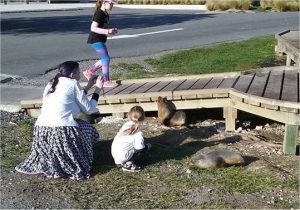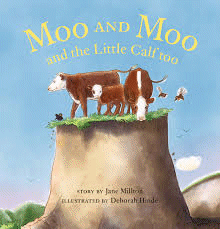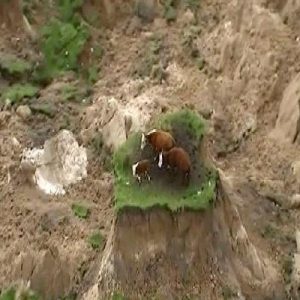Moo and Moo and the Little Calf too
Jane Millton
Deborah Hinde
Allen & Unwin, 2017
32pp., pbk., RRP $A17.99
9781877505928
Just after midnight on November 14, 2016 the earth under the north-east of New Zealand’s South Island started to shudder and shake. Once again an earthquake was reshaping the landscape as immovable forces fought for supremacy 15 000 metres below the surface – not just a regular shake that Kiwis are used to, this one was 7.8 on the Richter scale meaning widespread movement and damage.
Fast asleep in their paddock in the Clarence Valley on this bright moonlit night were two cows and a calf, who soon found themselves the subject of news footage around the world as the shaking and quaking split their sleep and their surroundings asunder and left them stranded on an island two metres high and 80 metres from where they started.
Told in rhyme, Moo and Moo and the Little Calf too tells the story of the three animals and how they were rescued, a story that will fascinate young readers. Imagine if the chair or the carpet they are sitting on suddenly moved and fell away and they were left stranded so high they couldn’t get down!
While there were many stories of the quake and its impact on the landscape and the people, just as there are about recent devastating weather events in Australia, we sometimes forget about the impact on the wildlife that such phenomena have. The destruction of their habitat, their dislocation from familiar food sources, their deaths and injuries are often overlooked as the human drama plays out. There was concern that the seal colony at Ohau Point (where I had been with my grandchildren exactly a year earlier) had been destroyed and with the seabed being lifted 5.5metres in places, also concern for the marine life off the coast.

So bringing this true story to life in a picture book that will endure much longer than a short television news clip not only tells the story of the cows but also puts a focus on other creatures who endure the trauma as humans do. What happened to the sealife, the birds, the kangaroos and all the other creatures during Cyclone Debbie and the resulting floods? How do they survive during devastating bushfires? What can be done to save them, help them, and restore their habitats? What are their needs? Even Kindergarten students can start investigations along those lines, giving meaning and purpose to the ubiquitous studies of Australia’s wildlife so they go beyond mere recognition.
While Moo and Moo and the Little Calf too might appear to have a limited audience and timeframe, used as a springboard it could be the beginning of something much greater. And that’s without even going down the path of the cause of earthquakes and how such events give us the landscapes and landshapes we are familiar with, or considering what’s in that floodwater they want to play in!

